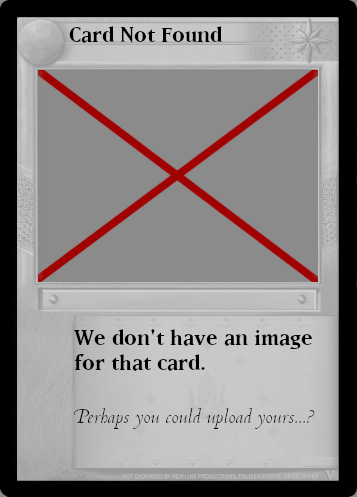The Nine Servants of Sauron (1U219)
Back to Fellowship of the Ring Index |
Not Easily Destroyed (1U220) |
General Strategy
"Nine rings where gifted to the race of men, who above all else desire power." - The Fellowship of the Ring.
In the twilight, these nine men became the Ringwraith, Servants to the Dark Lord Sauron. They live forever serving one Master, riding in darkness, seeking the One Ring.
Who has not seen a hobbit in the opponent's starting fellowship? Sam to remove burdens, Merry to add his strength to another companion, Pippin to play Gandalf or Aragorn -2 or to remove a burden. More and more, we see these little companions in fellowships, especially to reduce the number of races.
Their ability to exert or soak up archery is great with their 4 vitality, but what if a Shadow player could force them to exert for no reason? The Nine Servants of Sauron does just that. Each time you play a Nazgul, which is usually at least once per Shadow phase, you can force a hobbit to exert. That hobbit can even be an ally such as Bounder or Bilbo. This action will counter fellowship strategies such as Merry, Friend of Sam who needs to exert twice to add his strength to another companion, Sam, Son of Hamfast, who exerts to remove burdens.
Exerting unbound hobbits in the Shadow phase will also force your opponent to discard cards if they want to send their Ents to skirmishes. This is good if your local meta game is Gandalf/Ent based. These living trees have enough vitality to take the hits and enough strength to defeat the average minion.
Your playing environment is your first cue in deciding on the composition of your Shadow deck, and the decision to include The Nine Servants of Sauron is obviously heavily dependent upon whether exerting Hobbits will be more useful to you than anything else that could fill the card slots. >by Pascal Lajoie
Strengths and Weaknesses
Strong Versus...
- Unbound Hobbits and Sam (when not the ring-bearer)
- Hobbit Allies, particularly including Bounder
- With Ulaire Attea, the Easterling, you can exert a Hobbit ally with the condition then wound a Hobbit ally with the minion's text (see Rules and Clarifications)
Weak Versus...
- Decks without Hobbits
- Legolas, Dauntless Hunter with "bouncing" unbound Hobbits
Example Decks
Rules and Clarifications
In regards to the Ulaire Attea, the Easterling text "when you play" versus The Nine Servants of Sauron "Each time you play" text, per Page 3 of the CRD:
WHEN, EACH TIME, AND WHILE A few special words or phrases you’ll see in game text govern the timing of an action, just like the names of phases that are in phase actions. These include when, each time, and while; each is described below with an example.
• When is used if an effect can happen only once. When you play this possession, you may draw a card. This game text activates only once, when this card is played.
• Each time is used if an effect can happen more than once. Each time you play a possession or artifact on your companion, draw a card. If you play one possession, this game text activates once; if you play a second possession, it activates again, and so on.
• While is used if an effect is continuous. While Merry bears a weapon, he is strength +2. When you play a weapon on Merry, this game text is activated; if that weapon is discarded, then this game text “turns off.”
Each of these effects has a trigger describing what makes it happen. The trigger is always described first, and followed by a comma.
Extra Information
- Add other information regarding printing, rarity, trivia, etc.
